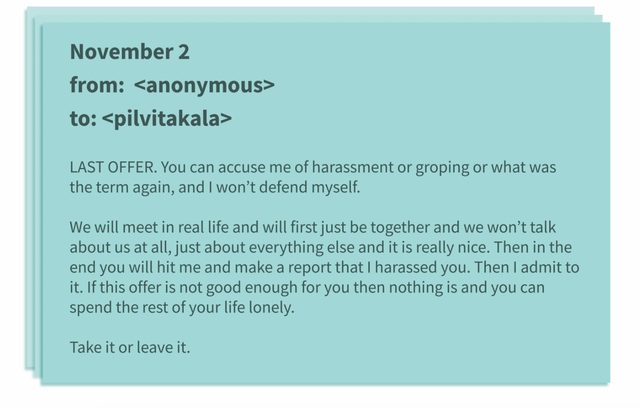
In Admirer the artist negotiates the terms of a contract with an anonymous person via email. Though initially the messages were only in response to Takala’s 20015 free text-messaging service Invisible Friend, the artist quickly began to receive a torrent of unwanted and often aggressive messages from Anonymous, across various online platforms.
Takala proposed a contract which would serve both as the basis of an art work and as a concrete justification for terminating all contact. This contract is an attempt to define the terms of their communication, and implement clear boundaries and objectives within their interaction. Over the two-month negotiation period, both parties contributed to and commented on the terms of the contract. Working together to formulate it, the process of negotiation itself existing both as a form of emotional labour and an attempt at self-preservation.
Admirer evidences a certain kind of gendered, online behavior, one in which the risk of reprisal is minimal. These attitudes are echoed across parts of our society, with the work being both about the themes which surface (e.g. entitlement, misogyny, harassment framed as romantic persistence) and the actual management of these issues. Both parties exercised power in this process, which Takala’s agency stemming from her clear intentions and control over the art-making- process, whilst Anonymous’ power lies in the concealing of their identity.
Admirer is currently also on view at Takala’s solo exhibition at the Kiasma Museum of Contemporary Art in Helsinki until February 17.
In examining how we manage and uphold implicit rules and unspoken boundaries Takala opens up a space for renegotiation of what is deemed appropriate and why. Her practice demonstrates that it is often possible to learn about the implicit norms of social structures only through their disruption. By intervening in the usual order of things Takala makes visible the processes of negotiation itself, allowing us to consider the complexity of navigating supposedly simple social situations. We may witness involuntary reactions, or sense conflict between what is said and what is gestured—a split second, a facial expression, a hesitation. To make visible the mechanics of negotiation is to see where and how people lay their boundaries, and ultimately how we may express consent with and without words.